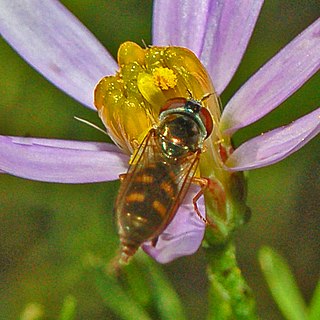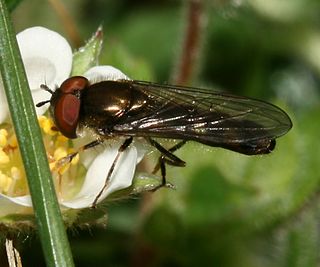
Platycheirus clypeatus is a species of hoverfly. It is found across the Palearctic and in the Nearctic. The larvae feed on aphids. Adults are usually found on the edges of woodland or scrub, heath or along hedgerows where they visit a wide range of flowers.

Platycheirus scambus is a species of hoverfly. It is a Holarctic species.

Platycheirus peltatus is a Palearctic species of hoverfly.

Platycheirus scutatus is a very common species of hoverfly. It is a Holarctic species.

Platycheirus albimanus is a common widespread species of hoverfly. A holarctic species its range includes Greenland, Iceland, Britain, mainland Europe, Russia, across Siberia to the pacific coast, the Philippines, Alaska, western Canada and United States.

Platycheirus granditarsus, the Hornhand Sedgesitter, is a species of hoverfly. It is found in many parts of Britain North America and Europe. Typical habitat includes marshy meadows and ditches, where it can be found between May and October, though it is at its commonest between July and September. The most distinctive feature of this fly is the red-orange abdomen most easily seen as it takes off or alights.

Platycheirus manicatus is a species of hoverfly. It is found across the Palearctic and in Alaska.

Platycheirus rosarum is a species of hoverfly found in the Holarctic realm. Like its close relative Platycheirus granditarsus, it can be found in marshy meadows and ditches; indeed, the two species can often be found together. The flight time is between May and October, though it peaks in abundance in June and July.

Platycheirus ambiguus is a small widespread species of hoverfly found across the Palearctic from Ireland to Japan. A spring species found in flight in April and May, it visits spring-flowering trees and shrubs, e.g., Prunus spinosa in deciduous woodland and scrub.
Platycheirus amplus is a Holarctic species of hoverfly found in wetlands, fens, moorland streams and bogs.

Platycheirus angustatus is a species of hoverfly. It is found in many parts of the Palearctic, and in the Nearctic.

Platycheirus discimanus, the Yellowfoot Sedgesitter is a small species of hoverfly. It is found across Europe and the Palearctic and in North America.

Platycheirus immarginatus, the Comb-legged Sedgesitter, is a common species of hoverfly. It is found in parts of northern Europe and northern North America.
Platycheirus nielseni is a Holarctic species of hoverfly.
Platycheirus podagratus is a species of hoverfly. It is found in the Holarctic.
Platycheirus modestus , also known as the yellow sedgesitter, is an uncommon species of syrphid fly observed throughout Northern North America. Hoverflies can remain nearly motionless in flight. The adults are also known as flower flies for they are usually found on flowers from which they get both energy-giving nectar and protein-rich pollen. Larvae are aphid predators.
Platycheirus nodosus, known as the twospear sedgesitter, is an uncommon species of syrphid fly observed in Canada and The Rocky Mountains. Hoverflies can remain nearly motionless in flight. The adults are also known as flower flies for they are commonly found on flowers from which they get both energy-giving nectar and protein-rich pollen. Larvae are aphid predators.
Platycheirus normae, the paddlearm sedgesitter, is a rare species of syrphid fly observed in northeastern North America. Hoverflies can remain nearly motionless in flight. The adults are also known as flower flies for they are commonly found on flowers, from which they get both energy-giving nectar and protein-rich pollen. Larvae are aphid predators.
Platycheirus thompsoni, or Thompson's sedgesitter, is an uncommon species of syrphid fly observed in northeastern North America. Hoverflies can remain nearly motionless in flight. The adults are also known as flower flies, for they are commonly found on flowers, from which they get both energy-giving nectar and protein-rich pollen. Larvae are aphid predators.
Platycheirus varipes is a rare species of syrphid fly observed in Northern Europe: Norway, Sweden, Finland; Greenland; central Asiatic Russia; and in North America from Alaska and Canada south to Colorado, via mountain chains.











